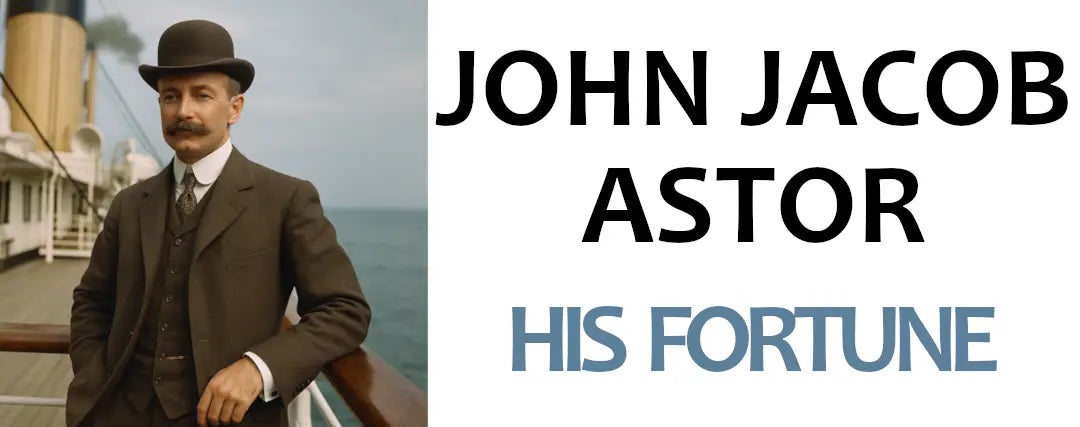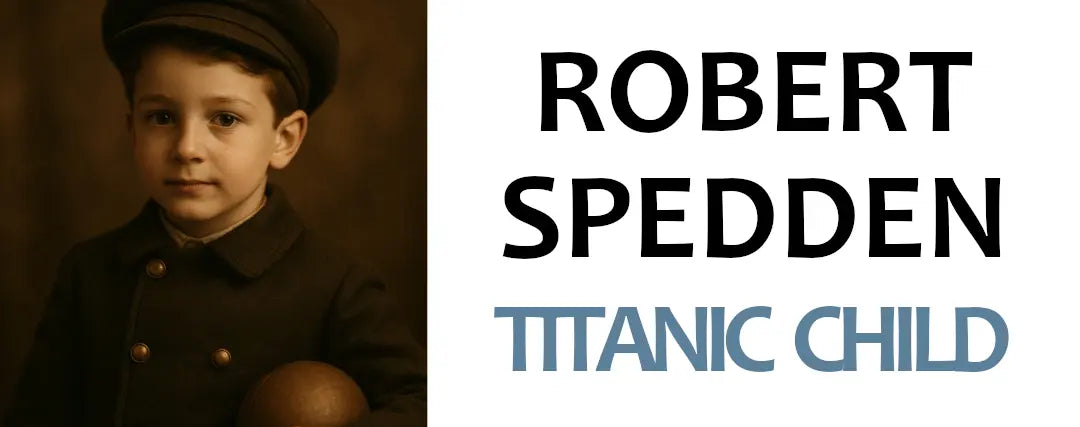Table of Contents
- 🎩 Introduction - Who Was John Jacob Astor IV?
- 💰 Who Was the Richest Person on the Titanic?
- 🏦 John Jacob Astor’s Fortune and Net Worth
- 🛳️ Did Madeleine Astor Survive the Titanic?
- 💍 Did Madeleine Force Astor Remarry?
- 📖 How True Is “The Second Mrs. Astor”?
- 👶 John Jacob Astor’s Children and Current Heirs
- 🏰 Is the Astor Family Still Rich Today?
- ⚖️ Who Was Richer: Vanderbilt or Astor?
- 💔 Why Did the Astors Divorce?
- ⛪ What Was John Jacob Astor’s Religion?
- 🏚️ Why Was the Astor Mansion Demolished?
- ⚰️ John Jacob Astor’s Death on the Titanic
- 🪦 Where Is Madeleine Astor Buried?
- 🎭 What Was Mary Astor’s Real Name?
- ❓ FAQ About John Jacob Astor and the Astor Family
- 📌 Conclusion - The Legacy of John Jacob Astor
🎩 Introduction - Who Was John Jacob Astor IV?
John Jacob Astor IV was one of the most famous and wealthy passengers aboard the Titanic. Born into the legendary Astor family, he represented the height of America’s Gilded Age elite.
More than just a millionaire, Astor was also an inventor, author, and visionary real estate developer. At the time of the Titanic’s maiden voyage in 1912, he was recognized as one of the richest men in the world.
Astor boarded the Titanic with his young wife, Madeleine Force Astor, who was nearly 30 years younger than him. Their relationship caused scandal in New York high society, but it also fascinated the press and the public.

Their story, a mixture of romance, wealth, scandal, and tragedy, continues to captivate historians and Titanic enthusiasts more than a century later. In this article, we’ll uncover the key moments of Astor’s life, fortune, and legacy, while answering the most common questions about him and his family.
💰 Who Was the Richest Person on the Titanic?
John Jacob Astor IV was widely reported as the richest passenger on the Titanic. Newspapers in 1912 estimated his wealth in the tens of millions of dollars, often around $80–90 million. Depending on how you convert it, that’s the equivalent of several billions today. This made Astor not only a celebrity of his age, but also a symbol of the Gilded Era’s confidence and extravagance.
Much of Astor’s wealth came from New York real estate. The family’s holdings stretched across prime Manhattan blocks. Add to that high‑profile hotel interests like the Waldorf‑Astoria, transportation and securities, and you get a diversified portfolio that kept the Astor name at the center of American high society. By 1912, few individuals could rival his consolidated personal fortune.

Astor’s presence on the maiden voyage drew intense attention. He traveled in first class with his young wife, Madeleine Astor, who was pregnant. Their appearances on deck, their accommodations, and their entourage were covered by the press as a form of living theater. In the public mind, Astor’s wealth and the Titanic’s luxury became intertwined, which is one reason his name remains so closely linked to the disaster.
🏦 John Jacob Astor’s Fortune and Net Worth
John Jacob Astor IV was part of the famous Astor family dynasty, a lineage that built its wealth through real estate, fur trading, and strategic investments. By the early 20th century, the Astors owned some of the most valuable properties in New York, including the Waldorf-Astoria Hotel, which symbolized luxury and modernity.
Astor’s personal fortune was estimated at 87 million dollars in 1912, a staggering sum that placed him among the wealthiest men on earth. When adjusted for inflation, this would amount to over 2.5 billion dollars today. His financial influence extended far beyond real estate, as he also invested in inventions, technology, and even wrote a science fiction novel entitled A Journey in Other Worlds.

This immense fortune not only made Astor a powerful figure in American high society, but also an influential voice in business and innovation. His wealth and reputation were key reasons why his presence on the Titanic was so widely reported, turning his tragic death into an international news story that echoed far beyond the maritime disaster itself.
➡️ Add a touch of timeless elegance to your style with the Titanic Bracelet.
🛳️ Did Madeleine Astor Survive the Titanic?
When the Titanic struck the iceberg on the night of April 14, 1912, John Jacob Astor was traveling with his young wife, Madeleine Force Astor, who was only 19 years old at the time and pregnant with their first child. The couple had boarded the ship in Cherbourg, France, after spending their honeymoon abroad.
As the evacuation began, Astor used his influence to try to secure a place for his wife on a lifeboat. Witnesses recalled that he pleaded for permission to accompany her, mentioning her pregnancy, but he was denied due to the strict "women and children first" rule that governed the evacuation process.

Madeleine was eventually placed safely in Lifeboat 4, one of the last boats to leave the ship. She survived the sinking, enduring the freezing night at sea before being rescued by the Carpathia. Sadly, her husband remained behind on the Titanic and perished in the disaster.
Her survival and the tragic loss of her husband made Madeleine one of the most talked-about figures in the aftermath of the sinking. She later gave birth to John Jacob Astor VI, who would grow up as the posthumous son and heir of the Astor fortune.
💍 Did Madeleine Force Astor Remarry?
After surviving the Titanic tragedy and giving birth to her son John Jacob Astor VI in August 1912, Madeleine Astor found herself one of the most famous widows of her time. At only 19 years old, she inherited significant wealth, but her life remained under the scrutiny of society and the press.
In 1916, just four years after the disaster, Madeleine shocked high society by remarrying William Vincent Dick, a childhood friend. The marriage drew attention because she was still so closely associated with her late husband, and her decision was often criticized by those who felt she should preserve the memory of John Jacob Astor IV.

Her remarriage also had financial consequences. According to the terms of her inheritance, Madeleine lost the income from a large portion of Astor’s estate upon remarrying. Nevertheless, she accepted this choice, prioritizing her personal happiness over material comfort, even if she still remained financially secure.
Madeleine’s second marriage did not last long. She later divorced and remarried again, living a quieter life compared to the sensational attention she received after the Titanic tragedy. Her remarriages reflect the complexity of being tied to one of the most tragic and publicized events of the 20th century while still trying to move forward with her own life.
➡️ Discover the unforgettable story of Rose DeWitt Bukater, the heroine who embodied love, freedom, and tragedy aboard the Titanic.
📖 How True Is “The Second Mrs. Astor”?
The story of John Jacob Astor IV and Madeleine Force Astor has inspired countless books, films, and articles. One of the most famous works dedicated to their relationship is the novel The Second Mrs. Astor by Shana Abé, which reimagines their love story in a romanticized and dramatic way.
While the book is based on real historical events, it also takes creative liberties to enhance the narrative. In reality, Madeleine was only 18 when she married Astor, a man 29 years older than her. Their age difference and the quickness of their marriage sparked controversy in early 20th century high society.

The novel captures the essence of their relationship and the tragedy of the Titanic, but it should not be taken as a literal account of what happened. For example, personal conversations and feelings are often dramatized to create emotional impact. However, the overall timeline of events, including the marriage, the voyage on the Titanic, and Astor’s heroic death, remains historically accurate.
Readers of The Second Mrs. Astor often feel a deep sense of empathy for Madeleine, who faced not only the trauma of the sinking but also the immense public pressure of being associated with the richest man on the Titanic. In that sense, the book successfully conveys the emotional weight of her story, even if some details are fictionalized.
➡️ Explore the story of Ruth DeWitt Bukater, the protective yet controversial mother who shaped Rose’s fate on the Titanic.
👶 John Jacob Astor’s Children and Current Heirs
John Jacob Astor IV had children from both of his marriages. With his first wife, Ava Lowle Willing, he had a son and a daughter: William Vincent Astor and Ava Alice Muriel Astor. After their divorce, these children became important figures in New York society, especially Vincent, who inherited a large portion of the Astor fortune after his father’s death on the Titanic.
With his second wife, Madeleine Force Astor, John Jacob Astor IV had one child: John Jacob Astor VI, who was born after the Titanic disaster in August 1912. Often referred to as the “Titanic Baby,” he carried a unique legacy, being the posthumous son of one of the richest men of the era. His birth ensured that Madeleine would always remain linked to the Astor family’s destiny.

Over the decades, the Astor heirs played significant roles in finance, philanthropy, and American society. Vincent Astor used his inheritance to fund major charitable foundations, while John Jacob Astor VI became known for his complicated legal battles over his inheritance. Today, the Astor name still exists in the United States and the United Kingdom, with descendants maintaining wealth and prestige, although not on the same scale as in the Gilded Age.
🏰 Is the Astor Family Still Rich Today?
The Astor family was once considered one of the wealthiest dynasties in the world, with vast holdings in real estate, hotels, and finance. In the 19th and early 20th century, their fortune symbolized the height of New York’s Gilded Age elite. However, over time, the family’s wealth was divided among many heirs and gradually diminished due to lifestyle, philanthropy, and economic changes.
Today, the Astor name still carries prestige, but the family is no longer among the richest in America. Some descendants live in the United States, while others are part of the British branch of the family, established in the early 20th century. This English branch, including members like William Waldorf Astor and his heirs, integrated into the British aristocracy and continue to hold influence in cultural and political circles.

Although the Astors do not appear on modern billionaire lists, their legacy remains tied to luxury, philanthropy, and high society. Many buildings, charities, and historical estates still carry the Astor name, keeping the family’s reputation alive long after the loss of their once-immense fortune.
⚖️ Who Was Richer: Vanderbilt or Astor?
During the late 19th and early 20th centuries, both the Astor and Vanderbilt families represented immense wealth and power in the United States. The Astors had built their empire primarily through real estate investments in New York City, while the Vanderbilts made their fortune in shipping and railroads.
At the peak of their power, the Vanderbilts were generally considered richer than the Astors. Cornelius Vanderbilt and his descendants amassed a fortune that at one point made them the wealthiest family in America. The Astors, however, were not far behind, and their status in New York high society often rivaled or even surpassed the Vanderbilts, thanks to their long-established influence and iconic presence in the city.

While the Vanderbilts may have held more wealth numerically, the Astors carried unmatched prestige in cultural and social spheres. In fact, during the Gilded Age, the phrase “the Four Hundred” — a reference to New York’s elite families — was closely associated with Caroline Astor, who dictated who belonged to the city’s highest social circles. Thus, the Astors’ power extended beyond money, into the realm of tradition and influence.
💔 Why Did the Astors Divorce?
The marriage between John Jacob Astor IV and his first wife, Ava Lowle Willing, ended in divorce in 1909 after nearly two decades together. Their separation caused a sensation in American society, since divorces among such wealthy and powerful families were rare and often seen as scandalous at the time.
The couple cited “irreconcilable differences,” but many historians believe that their personalities and ambitions simply grew apart. Ava was more focused on European society and culture, while John Jacob Astor was deeply involved in business and real estate. Rumors of infidelity also circulated, which may have contributed to the breakdown of their marriage.

The divorce settlement was one of the most expensive of its era, and Ava Willing moved to Europe shortly afterward. Just a year later, in 1911, Astor shocked the public by marrying Madeleine Force, a woman 29 years younger than him. This second marriage stirred controversy and added to the intrigue surrounding the Astor family.
⛪ What Was John Jacob Astor’s Religion?
John Jacob Astor IV was raised in the Episcopal Church, a branch of Anglicanism that was popular among America’s elite during the late 19th and early 20th centuries. Religion played a role in shaping the social networks of the Astor family, since church attendance was both a spiritual practice and a way to affirm their position in high society.

While not known as a deeply religious man in his personal life, Astor often supported Episcopal charities and institutions. His family’s connection to the church reflected the traditions of old New York families, where faith, wealth, and influence often intertwined.
Religion also shaped public perception of the Astors, who were seen as representatives of conservative values and American aristocracy. This background gave Astor a sense of respectability and stability, even though his personal decisions, such as marrying Madeleine Force, sparked controversy within the same social circles that valued religious propriety.
➡️ Discover the legacy of Captain Edward John Smith, the experienced commander whose final voyage was aboard the Titanic.
🏚️ Why Was the Astor Mansion Demolished?
The Astor Mansion, once one of the most opulent residences on Fifth Avenue in New York City, symbolized the extraordinary wealth and social power of the Astor family. Built in the late 19th century, it was a Gilded Age palace filled with European art, marble staircases, and grand ballrooms. For decades, it stood as a landmark of high society and was often used to host glamorous parties that defined New York’s elite lifestyle.
However, by the early 20th century, the area known as "Millionaire’s Row" on Fifth Avenue was rapidly changing. Commercial development began to take over, and many wealthy families chose to sell their mansions rather than maintain them. After John Jacob Astor IV’s death on the Titanic in 1912, the property passed into the hands of his heirs, but they found little use for such a massive residence in a city evolving toward skyscrapers and businesses.

In 1926, the Astor Mansion was demolished to make way for the Empire State Building’s neighbor, the Temple Emanu-El synagogue, which still stands today. The destruction of the mansion symbolized the decline of the old aristocratic lifestyle in New York and the transformation of Manhattan into a modern metropolis where private palaces gave way to commercial and public buildings.
The loss of the Astor Mansion reflects not only the fate of a family home but also the shift from the Gilded Age to a new era in American history. Today, the Astor name survives in history books and cultural memory, but their once-dominant presence on Fifth Avenue has completely disappeared.
⚰️ John Jacob Astor’s Death on the Titanic
On the night of April 14, 1912, when the Titanic struck the iceberg, John Jacob Astor IV was traveling with his young wife, Madeleine Astor, who was five months pregnant at the time. Witnesses recalled that Astor remained calm and collected during the evacuation, showing a sense of dignity even as panic spread throughout the ship.
Astor helped his wife secure a seat in lifeboat No. 4, reassuring her that he would soon follow once the women and children had been safely evacuated. According to survivors, he even asked if he could join her because she was expecting a child, but the crew refused, strictly enforcing the “women and children first” rule.

After the lifeboats were lowered, Astor was last seen standing on the deck, speaking calmly to fellow passengers. When the ship finally sank in the early hours of April 15, he was among the more than 1,500 people who perished in the freezing Atlantic waters. His body was later recovered by the cable ship MacKay-Bennett, identified by the initials stitched inside his clothing.
Reports of his recovery shocked the world, as he was the richest man to die in the Titanic disaster. In his pockets were a gold watch, money, and personal effects that were later given to his family. His death marked not only the loss of an American tycoon but also the end of an era in which the Astors represented unmatched wealth and social prestige.
➡️ Relive the magic as Titanic celebrates its 25th anniversary, a film that continues to move audiences worldwide.
🪦 Where Is Madeleine Astor Buried?
After surviving the Titanic tragedy, Madeleine Astor remarried twice and lived a life often under the public eye. Despite her attempts to maintain a degree of privacy, she was constantly linked to her first husband’s tragic fate aboard the Titanic. She passed away on March 27, 1940, at the age of 46, after suffering from heart failure.

Madeleine was buried at the Trinity Church Cemetery in New York City, one of the oldest and most historic cemeteries in Manhattan. Her final resting place is near other members of the Astor family, a lineage that left a significant mark on American history. Visitors still come to pay their respects, drawn both by her connection to the Titanic and her role in the enduring Astor story.
The grave of Madeleine Astor symbolizes more than just her personal life, it serves as a reminder of the human cost of the Titanic disaster and the way it forever altered the destiny of one of America’s most prominent families. Even today, her burial site attracts historians, Titanic enthusiasts, and those intrigued by the legacy of the Astors.
🎭 What Was Mary Astor’s Real Name?
The name Mary Astor often creates confusion, since she was not directly part of the Titanic’s Astor family but a famous Hollywood actress of the early 20th century. Born on May 3, 1906, her real name was Lucile Vasconcellos Langhanke. She adopted the stage name "Mary Astor" when she began her career in silent films, as it was more elegant and marketable to American audiences.

Although unrelated to John Jacob Astor IV or the prominent New York Astors, her surname created an interesting cultural overlap. Many people mistakenly believed she had some connection to the wealthy family that had perished on the Titanic. This misconception only added to the aura of glamour and prestige surrounding her acting career.
Mary Astor went on to become a highly respected actress, remembered especially for her role in The Maltese Falcon (1941) alongside Humphrey Bogart. Her story shows how the Astor name, whether by bloodline or by coincidence, has carried weight and recognition across different spheres of society, from finance and politics to tragedy and cinema.
❓ FAQ About John Jacob Astor and the Astor Family
💰 Who was the richest passenger on the Titanic?
The richest passenger aboard the Titanic was without a doubt John Jacob Astor IV, with an estimated net worth of around 87 million dollars in 1912, equivalent to several billions today. His fortune made him not only the wealthiest man on the ship but also one of the richest men in the world at the time.
🏦 How did the Astors lose their fortune?
Although John Jacob Astor IV left behind an immense fortune, it was gradually reduced over generations. Taxes, philanthropy, and lifestyle expenses played a role. Today, while the Astor family is still recognized, they no longer hold the same extraordinary wealth they once did during the Gilded Age.

🛳️ Did John Jacob Astor’s wife survive the Titanic?
Yes, Madeleine Astor, who was pregnant at the time, survived the sinking of the Titanic. She was placed in lifeboat 4 and rescued by the Carpathia. Her husband, John Jacob Astor IV, remained on board and perished in the disaster.
💍 Did Madeleine Astor remarry?
After the tragedy, Madeleine Astor later remarried. In 1916, she married William Vincent Dick, a young banker, though their marriage ended in divorce. She remarried again in 1933 to Enzo Fiermonte, an Italian actor, which also ended in divorce. Her personal life continued to attract media attention long after the Titanic disaster.
👶 Who is the current Astor heir?
The Astor lineage continues through John Jacob Astor VI, the son of Madeleine and John Jacob Astor IV, born after the Titanic sank. Over the years, different branches of the family have kept the name alive, though the title of “heir” has shifted among descendants like Vincent Astor and others in the extended Astor family.
⛪ What was John Jacob Astor’s religion?
John Jacob Astor IV was born into an Episcopalian family, part of the Protestant elite of New York. Religion played a significant role in shaping the values and social standing of the Astors, especially in a time when Protestant identity was tied closely to America’s financial and political elite.

🪦 Where is Madeleine Astor buried?
After her death in 1940, Madeleine Astor was buried at the Trinity Church Cemetery in New York City, the same resting place as many prominent Astor family members. Her grave remains a site of interest for Titanic historians and admirers of the Astor legacy.
🎭 What was Mary Astor’s real name?
Mary Astor, the Hollywood actress, was not related to the Titanic Astors. Her real name was Lucile Vasconcellos Langhanke. She adopted the name Mary Astor for her acting career, which led to confusion with the wealthy Astor dynasty.
📌 Conclusion - The Legacy of John Jacob Astor
The story of John Jacob Astor IV is not only the tale of one of the richest men on the Titanic, but also a reflection of the grandeur and fragility of the Gilded Age. His life embodied wealth, ambition, and societal prestige, while his tragic death on April 15, 1912, symbolized the vulnerability of even the most powerful individuals.

Through his young widow Madeleine Astor and their son John Jacob Astor VI, his lineage continued, although the Astor fortune would gradually diminish over generations. The family’s story remains an important chapter in American history, tied to themes of love, tragedy, and resilience.
Today, the name Astor continues to evoke images of wealth, influence, and legacy. Whether through their role in New York society, their grand mansions, or their tragic connection to the Titanic, the Astors remain a symbol of a bygone era that continues to fascinate the world.
*All illustrations featured in this article are original creations made by us for illustrative purposes only.
They do not depict the actual individuals mentioned and do not reproduce any elements protected by existing copyrights.






